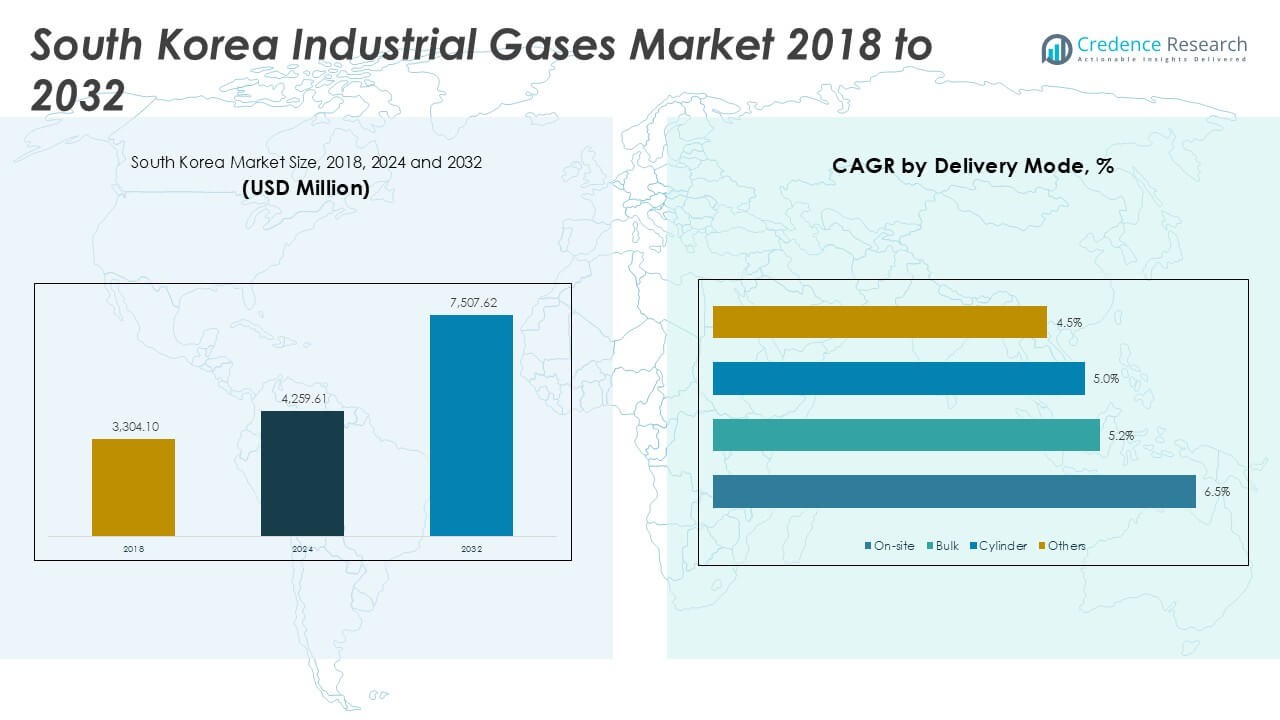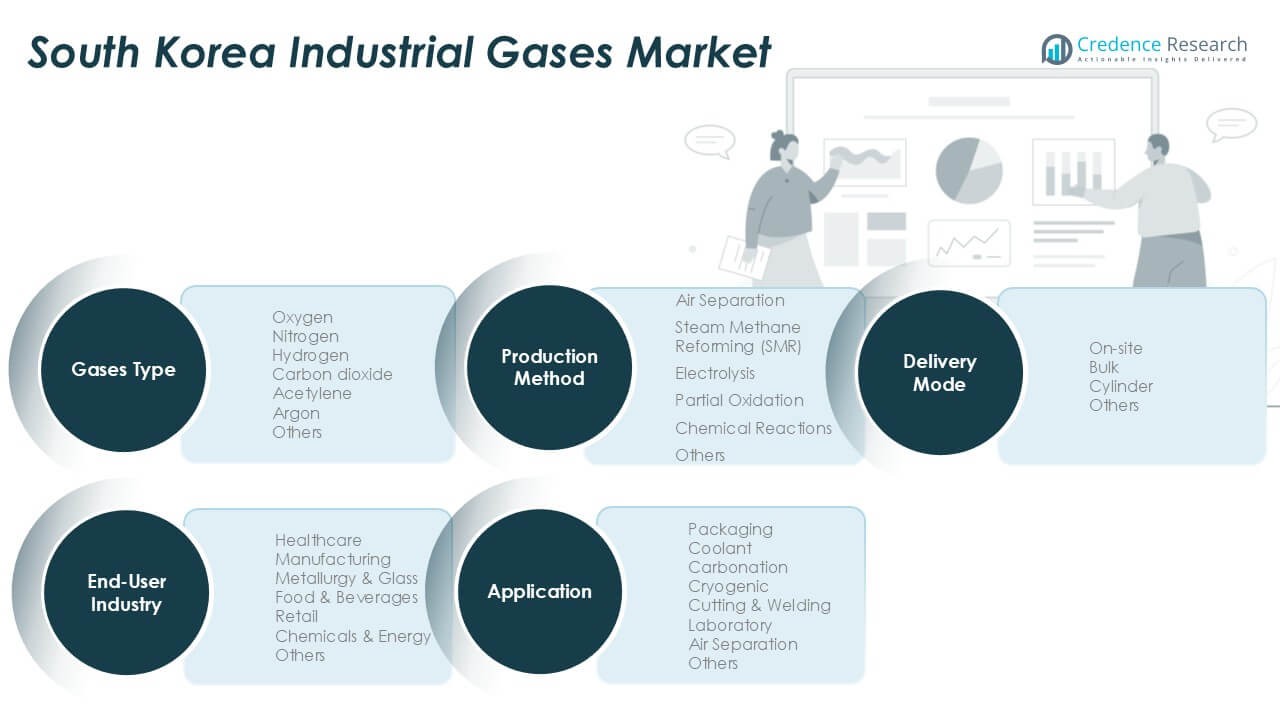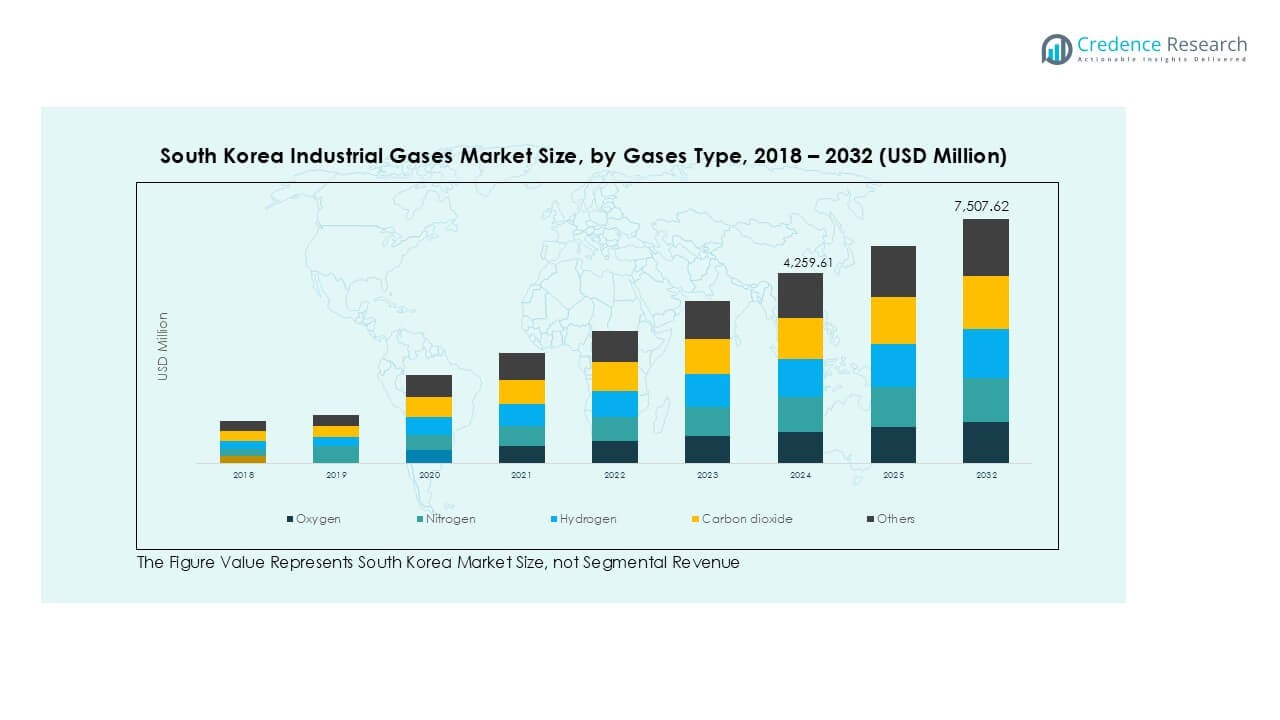Market Overview
South Korea Industrial Gases market size was valued at USD 3,304.10 million in 2018, reached USD 4,259.61 million in 2024, and is anticipated to reach USD 7,507.62 million by 2032, at a CAGR of 7.34% during the forecast period.
| REPORT ATTRIBUTE |
DETAILS |
| Historical Period |
2020-2023 |
| Base Year |
2024 |
| Forecast Period |
2025-2032 |
| South Korea Industrial Gases Market Size 2024 |
USD 4,259.61 Million |
| South Korea Industrial Gases Market, CAGR |
7.34% |
| South Korea Industrial Gases Market Size 2032 |
USD 7,507.62 Million |
The South Korea industrial gases market is led by major players such as Taiyo Nippon Sanso Corporation (TNSC), Iwatani Corporation, Air Liquide South Korea Ltd., Air Water Inc., Epson Gas, Showa Denko K.K., and Linde South Korea. These companies dominate through large-scale air separation units, robust distribution networks, and long-term supply agreements with shipbuilding, electronics, and healthcare industries. Seoul Metropolitan Region holds the largest share at 38%, driven by high demand from semiconductor manufacturing and hospital networks. Gyeonggi Province follows with 27%, supported by automotive and steel processing facilities. Busan and Ulsan together account for 20% market share, serving shipbuilding and petrochemical hubs, while Daegu contributes 15% through its growing manufacturing and healthcare sectors.
Access crucial information at unmatched prices!
Request your sample report today & start making informed decisions powered by Credence Research Inc.!
Download Sample
Market Insights
- The South Korea industrial gases market was valued at USD 4,259.61 million in 2024 and is projected to reach USD 7,507.62 million by 2032, growing at a CAGR of 7.34% during the forecast period.
- Demand is driven by strong manufacturing, shipbuilding, and healthcare expansion, with oxygen and nitrogen holding the largest share among gas types. Growing adoption of hydrogen for clean energy and fuel cell vehicles further boosts market growth.
- Trends include rising investment in cryogenic applications for LNG, on-site gas generation systems, and digital monitoring solutions. Specialty gases for semiconductors and biotechnology are witnessing significant growth.
- The market is moderately consolidated with key players such as TNSC, Iwatani Corporation, Air Liquide South Korea, Air Water Inc., and Linde focusing on capacity expansion, partnerships, and sustainable production methods.
- Seoul leads with 38% share, followed by Gyeonggi Province (27%), Busan & Ulsan (20%), and Daegu (15%), with manufacturing as the top end-use sector.
Market Segmentation Analysis:
By Gases Type
Oxygen holds the dominant share of over 30% in the South Korea industrial gases market, driven by strong demand from healthcare and steel production. Nitrogen follows closely, widely used in food packaging and electronics manufacturing for inerting and blanketing applications. Hydrogen demand is growing due to South Korea’s hydrogen economy roadmap and fuel cell vehicle initiatives. Carbon dioxide remains significant for carbonation and welding. Argon and acetylene cater to welding and cutting in manufacturing sectors. Increasing semiconductor and petrochemical production continues to boost overall consumption across multiple gas types.
- For instance, India, under its National Green Hydrogen Mission, aims for a green hydrogen production capacity of at least 5 million metric tons per annum by 2030.
By Application:
Cutting & welding leads the application segment with more than 25% share, supported by South Korea’s strong manufacturing and shipbuilding industries. Cryogenic applications are expanding due to growing demand for liquefied natural gas (LNG) storage and transport. Carbonation and packaging gases remain vital for food & beverage processing, driven by the country’s processed food exports. Air separation applications are witnessing investment in large-scale ASUs to support electronics and metallurgy. Laboratory and coolant gases are gaining traction with R&D expansion in biotech and advanced materials sectors.
- For instance, in 2023, the South Korea welding equipment market achieved revenues of approximately USD 282.7 million.
By End-User Industry:
Manufacturing is the largest end-user segment, accounting for nearly 35% market share, propelled by robust shipbuilding, electronics, and automotive industries. Healthcare is a fast-growing segment, with medical oxygen demand rising due to increasing hospital infrastructure and aging population. Metallurgy & glass industries rely heavily on oxygen and argon for smelting and refining. Food & beverages contribute significantly through carbonation and modified atmosphere packaging. Chemicals & energy sectors are key consumers of hydrogen and nitrogen, aligning with clean energy and refinery expansions across South Korea.

Key Growth Drivers
Rising Manufacturing and Shipbuilding Activities
South Korea’s strong shipbuilding and heavy manufacturing base drives large-scale consumption of industrial gases such as oxygen, nitrogen, and argon. Oxygen is used in steel cutting and welding, while nitrogen supports inerting and purging operations. Growth in shipbuilding exports and increasing investment in automotive and electronics production are boosting demand. This industrial expansion is encouraging gas producers to expand air separation units and supply networks to ensure reliable delivery, further supporting market growth across diverse manufacturing clusters.
- For instance, in 2024, South Korean shipbuilders booked orders totaling 10.98 million CGT, which represented approximately 17% of the global ship order share.
Government Push for Hydrogen Economy
The South Korean government’s hydrogen economy roadmap is a major demand driver for hydrogen production and distribution. Policies supporting fuel cell electric vehicles, hydrogen refueling stations, and green hydrogen projects are increasing investments in hydrogen infrastructure. Companies are developing large-scale hydrogen plants and collaborating with energy players to build supply chains. This transition is positioning hydrogen as a central industrial gas for energy decarbonization and mobility, significantly contributing to future market expansion in the country.
- For example, South Korea aims to increase domestic annual hydrogen consumption from about 130,000 tons in 2018 to nearly 5.3 million tons by 2040.
Healthcare Sector Expansion
South Korea’s growing healthcare infrastructure is driving higher consumption of medical oxygen, nitrous oxide, and other specialty gases. Hospitals and clinics are increasing oxygen storage and supply capacity to meet the needs of critical care and surgical procedures. Rising prevalence of respiratory illnesses and aging population is further accelerating demand. Domestic suppliers are enhancing production capacity and focusing on high-purity medical gas standards, ensuring reliable supply to healthcare facilities and supporting this segment’s steady growth trajectory.
Key Trends & Opportunities
Emergence of LNG and Cryogenic Applications
Cryogenic gas demand is rising due to South Korea’s LNG import and regasification projects. Industrial gas producers are investing in cryogenic storage tanks and transport solutions to support LNG terminals and shipping. This trend creates opportunities for suppliers of liquefied oxygen, nitrogen, and argon, which are critical for electronics, petrochemicals, and energy sectors. The growth of cryogenic infrastructure strengthens long-term demand for bulk gas supply and promotes the adoption of advanced storage and handling technologies.
- For instance, as of 2024 South Korea operates seven LNG import terminals with a combined regasification capacity of about 153 million tonnes per annum.
Digitalization and On-Site Gas Generation
Companies are adopting digital monitoring and automation to optimize gas production and distribution. On-site gas generation systems for oxygen and nitrogen are gaining traction, reducing dependence on cylinder delivery. These systems improve cost efficiency and reliability for end-users in manufacturing, healthcare, and electronics. The adoption of IoT-based gas management solutions also allows predictive maintenance and real-time tracking of usage, creating opportunities for suppliers to offer value-added services and strengthen long-term customer relationships.
- For example, the industrial oxygen generator market in Asia Pacific, including South Korea, is showing strong growth as more manufacturers deploy PSA-based on-site oxygen systems to meet demand in processing and healthcare sectors.
Key Challenges
High Production and Distribution Costs
Industrial gas production requires significant investment in air separation units, liquefaction plants, and distribution infrastructure. Rising electricity prices in South Korea increase operational costs, impacting profitability for suppliers. Transporting gases, particularly cryogenic liquids, also involves specialized logistics that add to expenses. Price fluctuations can discourage small and medium enterprises from adopting bulk gases, limiting demand growth in cost-sensitive industries. Suppliers must focus on energy efficiency and optimization to maintain competitiveness in the market.
Stringent Safety and Environmental Regulations
Industrial gas producers must comply with strict safety and environmental standards governing storage, handling, and emissions. Compliance requires continuous investment in advanced safety equipment and monitoring systems. Failure to meet regulations can lead to penalties, plant shutdowns, or supply disruptions. Additionally, the industry faces pressure to reduce carbon footprint and adopt greener production methods, such as renewable-powered electrolysis for hydrogen. Meeting these requirements can increase capital expenditure and slow down project timelines for new facilities.

Regional Analysis
Seoul Metropolitan Region
The Seoul Metropolitan Region holds the largest share, accounting for 38% of the South Korea industrial gases market. The region’s dominance is supported by a dense concentration of hospitals, research centers, and semiconductor facilities, driving demand for oxygen, nitrogen, and specialty gases. Major electronics manufacturing and R&D investments further boost gas consumption. The presence of advanced logistics networks allows suppliers to deliver bulk and cylinder gases efficiently. Increasing healthcare infrastructure and growing demand for high-purity gases in the biotech sector are expected to sustain strong growth in the region over the forecast period.
Gyeonggi Province
Gyeonggi Province represents about 27% of the market, driven by its thriving manufacturing base and proximity to major industrial clusters. The province is a hub for automotive, shipbuilding component manufacturing, and steel processing industries, generating steady demand for cutting, welding, and inerting gases. Growing electronics assembly operations in this area contribute to higher consumption of high-purity nitrogen and specialty gases. Investments in industrial parks and logistics infrastructure are strengthening the regional supply chain, supporting expansion of production facilities and air separation units to meet the rising requirements of manufacturing and energy-related applications.
Busan and Ulsan Regions
Busan and Ulsan together account for nearly 20% of South Korea’s industrial gases market. These regions serve as the country’s maritime and heavy industrial hubs, with strong shipbuilding, petrochemical, and refining activities. Oxygen and argon are widely used for welding and metal fabrication, while hydrogen and nitrogen are in demand for refining and chemical processes. The presence of LNG terminals in Ulsan is also driving growth for cryogenic gas applications. Increasing export activity and ongoing expansion of petrochemical complexes are expected to further support long-term demand in these coastal regions.
Daegu Region
Daegu holds around 15% market share, supported by its growing role as a manufacturing and healthcare hub. The city’s textile, machinery, and automotive component industries are significant users of cutting, welding, and inerting gases. Demand for medical oxygen is also increasing due to rising investment in hospital and diagnostic infrastructure. Daegu’s position as a logistics center in southeastern Korea facilitates efficient gas distribution to surrounding areas. Continued government support for smart manufacturing and Industry 4.0 adoption in the region is expected to boost consumption of high-purity and specialty gases over the coming years.

Market Segmentations:
By Gases Type
- Oxygen
- Nitrogen
- Hydrogen
- Carbon Dioxide
- Acetylene
- Argon
- Others
By Application
- Packaging
- Coolant
- Carbonation
- Cryogenic
- Cutting & Welding
- Laboratory
- Air Separation
- Others
By End-User Industry
- Healthcare
- Manufacturing
- Metallurgy & Glass
- Food & Beverages
- Retail
- Chemicals & Energy
- Others
By Production Method
- Air Separation
- Steam Methane Reforming (SMR)
- Electrolysis
- Partial Oxidation
- Chemical Reactions
- Others
By Delivery Mode
- On-site
- Bulk
- Cylinder
- Others
By Geography
- Seoul Metropolitan Region
- Gyeonggi Province
- Busan and Ulsan Regions
- Daegu Region
Competitive Landscape
The South Korea industrial gases market is moderately consolidated, with key players including Taiyo Nippon Sanso Corporation (TNSC), Iwatani Corporation, Air Liquide South Korea Ltd., Air Water Inc., Epson Gas, Showa Denko K.K., and Linde South Korea. These companies focus on expanding production capacity through new air separation units, on-site gas generation systems, and strategic partnerships with manufacturing and energy firms. Hydrogen production and distribution projects are a priority, aligning with South Korea’s hydrogen economy roadmap. Players are also investing in cryogenic storage, digital monitoring systems, and sustainable gas production methods to reduce carbon emissions. Mergers, acquisitions, and long-term supply contracts with semiconductor, healthcare, and shipbuilding industries strengthen market positions. Intense competition drives innovation in cost-efficient supply solutions and specialty gas development, enabling companies to cater to high-purity requirements in electronics, medical, and research applications while maintaining strong regional distribution networks across major industrial clusters.
Shape Your Report to Specific Countries or Regions & Enjoy 30% Off!
Key Player Analysis
Recent Developments
- In October 2024, Air Liquide announced to supply oxygen to LG Chem for their electric vehicle battery plant in the U.S. Supplying oxygen to LG Chem’s future cathode active material plant, the Group will be supporting the growth of the battery ecosystem in the U.S. This investment will increase the Group’s footprint in a key region and support the development of its industrial merchant market.
- In October 2024, Linde announced an agreement with Tata Steel to obtain and manage two additional Air Separation Units (ASUs) and enhance industrial gas supply to Tata Steel in Odisha, India. This arrangement will more than double Linde’s on-site capacity at Tata Steel’s Kalinganagar facility, where it presently runs two plants. The new ASUs, anticipated to be operational by 2025, will deliver oxygen, nitrogen, and argon to aid Tata Steel’s expansion project and cater to the local merchant market. Linde has additionally acquired renewable energy agreements to lower its scope emissions, in line with its 2035 GHG reduction goals.
- In July 2024, Air Liquide announced an investment of USD 104.914 million to support Aurubis AG, a major global provider of non-ferrous metals and one of the largest recyclers of copper worldwide, in Bulgaria and Germany. This investment will finance a new Air Separation Unit (ASU) in Bulgaria and the upgrading of four existing units in Germany. Besides supplying substantial amounts of oxygen and nitrogen for the rising copper and other metal production by Aurubis, these facilities will also assist in the growth of industrial merchant markets in both areas.
- In January 2024, Air Products, a company in industrial gases and clean hydrogen projects, announced the opening of its expanded Project Delivery Centre in Vadodara, India.
- In July 2023, Nippon Sanso Holdings Corporation announced that Matheson Tri-Gas, Inc, NSHD’s U. S. operating entity, has entered into a gas supply contract with PointFive to deliver oxygen for the carbon capture, utilization, and sequestration company’s inaugural Direct Air Capture (DAC*) facility in Texas. MATHESON will invest in and set up an Air Separation Unit to provide oxygen to “Stratos,” PointFive’s DAC facility currently under construction in Ector County, Texas. The oxygen is utilized in the DAC process to generate a pure stream of CO2, which is subsequently securely sequestered in geological reservoirs.
Report Coverage
The research report offers an in-depth analysis based on Gases Type, Application, End-User Industry, Production Method, Delivery Mode and Geography. It details leading market players, providing an overview of their business, product offerings, investments, revenue streams, and key applications. Additionally, the report includes insights into the competitive environment, SWOT analysis, current market trends, as well as the primary drivers and constraints. Furthermore, it discusses various factors that have driven market expansion in recent years. The report also explores market dynamics, regulatory scenarios, and technological advancements that are shaping the industry. It assesses the impact of external factors and global economic changes on market growth. Lastly, it provides strategic recommendations for new entrants and established companies to navigate the complexities of the market.
Future Outlook
- Demand for industrial gases will grow steadily, supported by expanding manufacturing and electronics production.
- Hydrogen will become a major growth area as South Korea advances its hydrogen economy roadmap.
- On-site gas generation systems will gain adoption to reduce logistics costs and ensure uninterrupted supply.
- Cryogenic applications will rise with LNG import expansion and storage infrastructure development.
- Specialty gases for semiconductor and biotechnology industries will see increased demand.
- Medical oxygen consumption will grow with rising healthcare infrastructure and aging population needs.
- Companies will invest in energy-efficient air separation units to lower operational costs.
- Partnerships and long-term supply agreements will strengthen distribution networks across industrial clusters.
- Digital monitoring and IoT-based gas management will improve efficiency and reliability.
- Sustainability efforts will push producers toward low-carbon and green hydrogen production methods.






